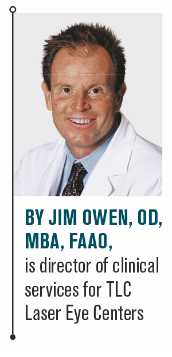Choose your words carefully with surgery patients


“Oops”-it is a short, one-syllable word that most of us use on occasion-but never by surgeons.
Eye surgery is scary for most patients. Therefore, they hang on every word you say and have responses far different from your contact lens or glaucoma patients.
I first became aware of the importance of words in refractive surgery from John W. Potter, OD. Dr. Potter describes the goal of laser vision correction (LASIK) as “20/happy.”
While it may sound corny at first, it is a phrase I have used for over 20 years with laser vision correction patients I have counseled.
Read more about refractive surgery
Today, with escalating expectations, the phrase “20/happy” may be more valuable than ever.
Patient communication
This phrase can flush out the patient with unrealistic expectations. Occasionally, a patient will say, “No, I want my vision perfect.”
My next move is to ask, “What do you mean by perfect?” If the patient does not have a satisfactory answer for that question, then I would say, “Surgery is never perfect and maybe this elective procedure is not for you.”
Either way we both have learned something and are closer to setting realistic expectations.
Previously by Dr. Owen: How hyperopes differ from myopes
Several phrases we use as clinicians warrant a funny look from patients.
Let me start with “comanagement.” Eyecare professionals know what that word means, but most patients haven’t a clue. To tell a patient “I comanage with Dr. Gordon,” means nothing to a patient. I prefer, “Dr. Gordon is a surgeon I work closely with, and he did my mom’s LASIK.”
I let patients know I provide the care before and after surgery (not pre-op and postop), and answer any questions they have about the procedure. I think it humanizes that conversation.
Book analogy
Whether the surgeon uses a microkeratome blade or a femtosecond laser, the creation of the LASIK flap is a dissection of the anterior cornea and then the excimer laser vaporizes corneal tissue.
I prefer to use the book analogy when discussing this with patients: I tell them to think of their cornea as a 540-page book. The surgeon opens the book to page 110 and lasers away 60 pages, leaving 370 pages in the book.
The FDA says we need to leave at least 250 pages in the book, so we are safely above that limit.
The book analogy is quick and easy to adapt to individual patients. They typically nod their heads in agreement as opposed to furrowing their brows if you say a blade is going across their corneas to dissect a flap.
LASIK versus PRK
It also makes it easy to describe the difference from photorefractive keratectomy (PRK):
In PRK, the surgeon removes the cover, lasers away 60 pages in the same manner, and it takes three to five days for the cover to grow back. A simple and concise procedure.
Related: Prepare your patients for PRKCataract surgery
Describing cataract surgery can be just as simple, with only five basic steps. If I am discussing femtosecond cataract surgery, I will say the laser does the first three of the five steps:
First, the surgeon uses the laser to create an incision in the cornea, which allows him to enter the eye with the new lens.
Second, the laser opens the capsule around your lens in a perfect circle. This capsule will hold the new lens in place.
Third, the laser breaks apart your cloudy lens, so the pieces are easy to remove.
The fourth step is to vacuum out the pieces and-finally-in the fifth step the surgeon puts the new lens in place.
Related: 6 steps to prepare former LASIK patients for cataract surgeryPotential outcomes
Prior to laser vision correction, I discuss with patients the likely outcomes based on their refractive errors. I speak about the potential of performing a second (enhancement) procedure to get them to “20/happy,” and am careful to explain that some patients “over-respond” to the laser while others “under-respond.”
A patient who starts at -4.00 D and ends at -0.50 D is undercorrected, but the treatment was not an under correction. It is not the same as if we put a -3.50 D contact lens on the patient.
The patient’s healing response to the laser applied to their cornea was less than predicted-in this example, approximately 8 µm less. Over- and under-responses are healing concerns, not treatment errors-a significant distinction.
Postop care
Describing the postoperative care of LASIK to patients is a delicate balance of its contrasting simplicity and significance.
The worst post-LASIK infection I have seen was a patient who had his surgery outside the U.S., went out drinking that night with his surgeon, and then went surfing the next day.
The extreme pain and “count fingers” vision motivated him to seek treatment from a new doctor. This patient under-estimated the significance of the post-operative care.
When discussing care after surgery, I am direct in stating the need to take the anti-infection drop and anti-inflammation drop to assure a patient’s eyes heal properly.
Related: How to handle vision changes over time post-LASIK
I am just as direct in including artificial tears in the patient’s postoperative drop prescription. Without getting deep into clinical studies, I tell patients most everyone feels dry and has fluctuating vision at one week, and still half of my patient have some but less of those symptoms at one month.
By three months, those symptoms are usually gone.
Realistic expectations
The magic of LASIK is how well patients see the next day-but it does not mean all is done. Patients often ask when their eye will be “healed” at the one-day visit.
I try to keep it simple and say that just bumping the flap can dislodge it during the first week, rubbing can dislodge it during the first month, and beyond a month it takes trauma to dislodge the flap.
When patients ask when they can get back to “exercise,” it is important to ask what they mean by exercise. To some, exercise is walking; however, to others it is Brazilian jiu-jitsu. It is always good to know specifically what the patient means.
Presbyopia
When I am in my private practice, I do not have all the answers about appropriate patient candidates. But the answer I do have-that the surgery center is most interested in-is presbyopia.
There are 50-year-old -2.00 D myopes who are great candidates for LASIK, and there are those who are horrible candidates. It is not until you have the discussion about vision within arms-length does a patient begin to know in which bucket he belongs.
Related: Managing presbyopia with surgery
This conversation ranges from short and concise to long and confusing. No matter how tedious the conversation, it is exponentially more valuable prior to surgery than after.
Your knowledge of the patient’s visual needs and your ability to communicate to that patient is valuable to him achieving “20/happy.”
You can leave the discussion of progression index and ArtMax to the laser center, but the presbyopia discussion is best in the optometrist’s office.
Patient discussion
The past 20 years have seen dramatic advances in the technology of laser vision correction. Interwoven within all this innovation is a 2019 patient who desires a unique understanding of this procedure.
When efficiently explained, the results can be remarkable.
Read more by Dr. Owen

Newsletter
Want more insights like this? Subscribe to Optometry Times and get clinical pearls and practice tips delivered straight to your inbox.